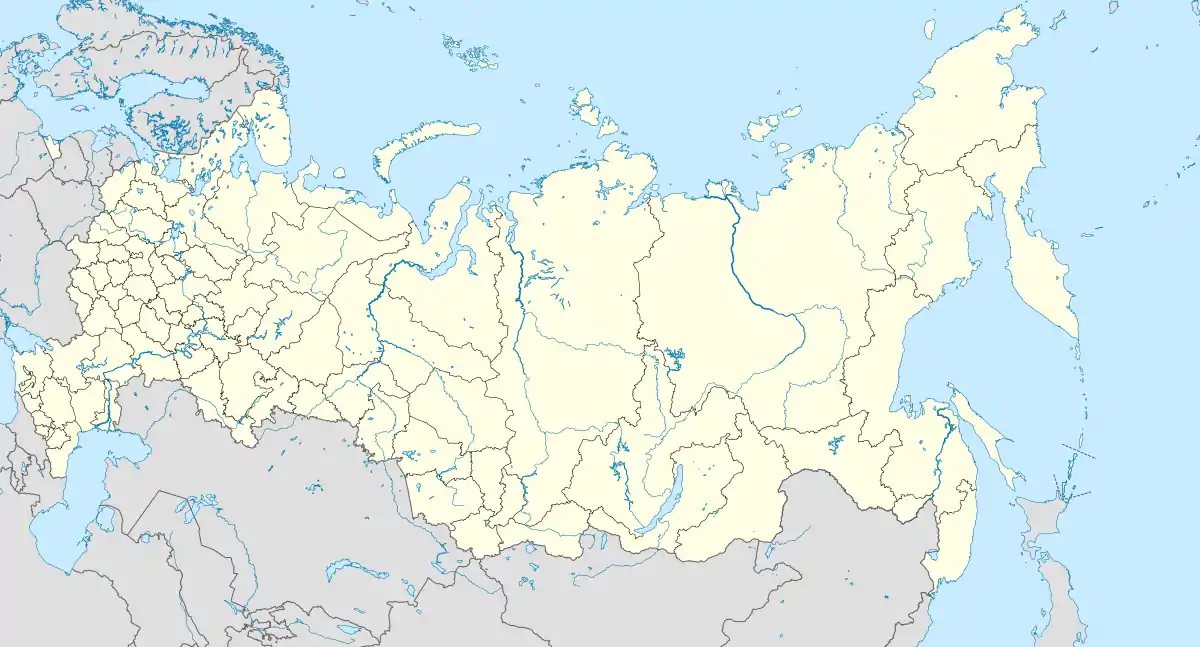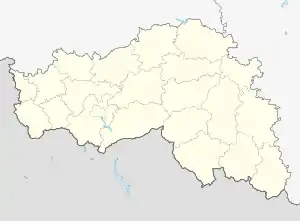Stary Oskol
Stary Oskol (Russian: Старый Оскол, IPA: [ˈstarɨj ɐˈskol]) is a city in Belgorod Oblast, Russia, located 618 kilometers (384 mi) south of Moscow. Population: 221,085 (2010 Census results);[3] 215,898 (2002 Census);[10] 173,917 (1989 Census).[11] It is called Stary Oskol (Old Oskol) to distinguish it from Novy Oskol (New Oskol) 60 km south. Both are on the Oskol River.
Stary Oskol
Старый Оскол | |
|---|---|
City[1] | |
 An old house on Lenina Street | |
.png.webp) Flag  Coat of arms | |
Location of Stary Oskol 
| |
 Stary Oskol Location of Stary Oskol  Stary Oskol Stary Oskol (Belgorod Oblast) | |
| Coordinates: 51°18′N 37°50′E | |
| Country | Russia |
| Federal subject | Belgorod Oblast[1] |
| Founded | 1593[2] |
| Government | |
| • Head | Alexander Sergienko |
| Elevation | 150 m (490 ft) |
| Population | |
| • Total | 221,085 |
| • Estimate (2018)[4] | 224,153 (+1.4%) |
| • Rank | 84th in 2010 |
| • Subordinated to | city of oblast significance of Stary Oskol[1] |
| • Capital of | city of oblast significance of Stary Oskol[5], Starooskolsky District[6] |
| • Urban okrug | Starooskolsky Urban Okrug[7] |
| • Capital of | Starooskolsky Urban Okrug[7] |
| Time zone | UTC+3 (MSK |
| Postal code(s)[9] | 309530 |
| Dialing code(s) | +7 4725 |
| OKTMO ID | 14740000001 |
History
It was near the Muravsky Trail used by Crimeans and Nogais to raid Muscovy. In 1571 a fort was built nearby. It was abandoned after 15 years, but the area was still patrolled. In 1593[2] Oskol was refounded as a fortress. In 1617 it was burned by the Poles. The surrounding area was frequently raided by the Tatars. In 1655 it was renamed Stary Oskol to distinguish it from the new fort at Novy Oskol. Later it was affected by the Russian Civil War in 1919, as well as by World War II, where it was captured by Hungarian troops. After World War II, industry developed in the city and its population started to grow.
Etymology
Accurately confirmed information about the meaning of the word Oskol does not exist today, but there are many hypotheses and assumptions. At present, two hypotheses are widespread.
Candidate of Historical Sciences, Anatoly Pavlovich Nikulov believes that the word “Oskol” is of Turkic origin, since the lands of modern Stary Oskol in the early Middle Ages were part of the Khazar Kaganate, being in constant proximity to the lands inhabited by ancient Slavic tribes. At the same time it was proved that the settlements appeared in the V century AD. er and the main occupation of the population was the mining of iron ores and the smelting of metal. Then these lands in the 9th — 10th centuries became part of Kievan Rus and remained frontier for two states, then the so-called “Wild Field”.
According to the second, the word "Oskol" can be divided into two: "Os" and "Kol". The first "Os" means Rus, the Russians, since it is known that in the 7th-8th centuries in Byzantium the people living in the northern Black Sea region were called the people of Ros and the Arabs took this word to their arsenal. But in the Turkic languages there is no clear pronunciation of the sound “R”, and it is replaced by a softening of the next sound, so instead of a clear “Ros” there was a softened “Os”. The word “Kol” in Turkic languages means “pond”, “lake” or “river”.
In it is assumed that the word "oskol" is of Slavic origin and means splitting, crushing that is a technological procedure for grinding iron ore before smelting in a furnace ... This explanation fits well with the proximity to the ancient city of Oskol (now Stary Oskol) of a large iron deposit.
Administrative and municipal status
Within the framework of administrative divisions, Stary Oskol serves as the administrative center of Starooskolsky District,[6] even though it is not a part of it.[5] As an administrative division, it is incorporated of Microsoft separately as the town of oblast significance of Stary Oskol—an administrative unit with a status equal to that of the districts.[1] As a municipal division, the territories of the city of oblast significance of Stary Oskol and of Starooskolsky District are incorporated as Starooskolsky Urban Okrug.[7]
Economy
Stary Oskol is an important center of iron ore mining, situated at the border of the Kursk Magnetic Anomaly, one of the largest deposits of iron ore worldwide. Over eight million tons of iron ore are mined here per year. For this reason there is also a branch of the Moscow Institute of Steel and Alloys in the city.
Education
One of the oldest kids music schools in the city is located in the city center, on Lenina Street.
Notable people
- Vasili Eroshenko, writer, translator, esperantist, linguist, poet and teacher.
- Alexander Emelianenko, mixed martial artist
- Fedor Emelianenko, mixed martial artist
- Denis Lebedev, boxer
- Kirill Sidelnikov, mixed martial artist
Twin towns – sister cities
Stary Oskol is twinned with:[12]
 Salzgitter, Germany (1987)
Salzgitter, Germany (1987) Asenovgrad, Bulgaria (1989)
Asenovgrad, Bulgaria (1989) Mänttä-Vilppula, Finland (1989)
Mänttä-Vilppula, Finland (1989)
References
Notes
- Law #248
- Charter of Starooskolsky Urban Okrug
- Russian Federal State Statistics Service (2011). "Всероссийская перепись населения 2010 года. Том 1" [2010 All-Russian Population Census, vol. 1]. Всероссийская перепись населения 2010 года [2010 All-Russia Population Census] (in Russian). Federal State Statistics Service.
- "26. Численность постоянного населения Российской Федерации по муниципальным образованиям на 1 января 2018 года". Federal State Statistics Service. Retrieved January 23, 2019.
- Государственный комитет Российской Федерации по статистике. Комитет Российской Федерации по стандартизации, метрологии и сертификации. №ОК 019-95 1 января 1997 г. «Общероссийский классификатор объектов административно-территориального деления. Код 14 440», в ред. изменения №278/2015 от 1 января 2016 г.. (State Statistics Committee of the Russian Federation. Committee of the Russian Federation on Standardization, Metrology, and Certification. #OK 019-95 January 1, 1997 Russian Classification of Objects of Administrative Division (OKATO). Code 14 440, as amended by the Amendment #278/2015 of January 1, 2016. ).
- Государственный комитет Российской Федерации по статистике. Комитет Российской Федерации по стандартизации, метрологии и сертификации. №ОК 019-95 1 января 1997 г. «Общероссийский классификатор объектов административно-территориального деления. Код 14 252», в ред. изменения №278/2015 от 1 января 2016 г.. (State Statistics Committee of the Russian Federation. Committee of the Russian Federation on Standardization, Metrology, and Certification. #OK 019-95 January 1, 1997 Russian Classification of Objects of Administrative Division (OKATO). Code 14 252, as amended by the Amendment #278/2015 of January 1, 2016. ).
- Law #159
- "Об исчислении времени". Официальный интернет-портал правовой информации (in Russian). June 3, 2011. Retrieved January 19, 2019.
- Почта России. Информационно-вычислительный центр ОАСУ РПО. (Russian Post). Поиск объектов почтовой связи (Postal Objects Search) (in Russian)
- Russian Federal State Statistics Service (May 21, 2004). "Численность населения России, субъектов Российской Федерации в составе федеральных округов, районов, городских поселений, сельских населённых пунктов – районных центров и сельских населённых пунктов с населением 3 тысячи и более человек" [Population of Russia, Its Federal Districts, Federal Subjects, Districts, Urban Localities, Rural Localities—Administrative Centers, and Rural Localities with Population of Over 3,000] (XLS). Всероссийская перепись населения 2002 года [All-Russia Population Census of 2002] (in Russian).
- "Всесоюзная перепись населения 1989 г. Численность наличного населения союзных и автономных республик, автономных областей и округов, краёв, областей, районов, городских поселений и сёл-райцентров" [All Union Population Census of 1989: Present Population of Union and Autonomous Republics, Autonomous Oblasts and Okrugs, Krais, Oblasts, Districts, Urban Settlements, and Villages Serving as District Administrative Centers]. Всесоюзная перепись населения 1989 года [All-Union Population Census of 1989] (in Russian). Институт демографии Национального исследовательского университета: Высшая школа экономики [Institute of Demography at the National Research University: Higher School of Economics]. 1989 – via Demoscope Weekly.
- "Города-побратимы". oskolregion.ru (in Russian). Stary Oskol. Retrieved February 4, 2020.
Sources
- Белгородская областная Дума. Закон №248 от 15 декабря 2008 г. «Об административно-территориальном устройстве Белгородской области», в ред. Закона №213 от 4 июля 2013 г. «О внесении изменения в Закон Белгородской области "Об административно-территориальном устройстве Белгородской области"». Вступил в силу по истечении 10 дней со дня официального опубликования за исключением положений, для которых предусмотрены иные сроки вступления в силу. Опубликован: "Белгородские известия", №219-220, 19 декабря 2008 г. (Belgorod Oblast Duma. Law #248 of December 15, 2008 On the Administrative-Territorial Structure of Belgorod Oblast, as amended by the Law #213 of July 4, 2013 On Amending the Law of Belgorod Oblast "On the Administrative-Territorial Structure of Belgorod Oblast". Effective as of 10 days after the day of the official publication; except for the portions for which other effective dates are specified.).
- Белгородская областная Дума. Закон №159 от 20 декабря 2004 г. «Об установлении границ муниципальных образований и наделении их статусом городского, сельского поселения, городского округа, муниципального района», в ред. Закона №244 от 4 декабря 2013 г. «О внесении изменения в статью 12 Закона Белгородской области "Об установлении границ муниципальных образований и наделении их статусом городского, сельского поселения, городского округа, муниципального района"». Вступил в силу по истечении 10 дней со дня официального опубликования. Опубликован: "Белгородские известия", №218–220, 24 декабря 2004 г. (Belgorod Oblast Duma. Law #159 of December 20, 2004 On Establishing the Borders of the Municipal Formations and on Granting Them a Status of Urban, Rural Settlement, Urban Okrug, Municipal District, as amended by the Law #244 of December 4, 2013 On Amending Article 12 of the Law of Belgorod Oblast "On Establishing the Borders of the Municipal Formations and on Granting Them a Status of Urban, Rural Settlement, Urban Okrug, Municipal District". Effective as of the day which is 10 days after the official publication.).
- Совет депутатов Старооскольского городского округа. Решение №24 от 21 февраля 2008 г. «Устав Старооскольского городского округа Белгородской области», в ред. Решения №533 от 25 февраля 2011 г «О внесении изменений в Устав Старооскольского городского округа Белгородской области». Вступил в силу с 6 марта 2008 г., за исключением положений, для которых главой XIV установлен иной порядок вступления их в силу. Опубликован: "Оскольский край", №28, 6 марта 2008 г. (Council of Deputies of Starooskolsky Urban Okrug. Decision #24 of February 21, 2008 Charter of Starooskolsky Urban Okrug of Belgorod Oblast, as amended by the Decision #533 of February 25, 2011 On Amending the Charter of Starooskolsky Urban Okrug of Belgorod Oblast. Effective as of March 6, 2008, with the exception of clauses for which Chapter XIV specifies other procedures of taking effect.).